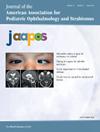Long-term outcomes of Ahmed glaucoma drainage device capsulectomies in pediatric glaucoma patients
IF 1.2
4区 医学
Q3 OPHTHALMOLOGY
引用次数: 0
Abstract
Purpose
To investigate the long-term outcomes associated with Ahmed glaucoma device capsulectomy in pediatric patients at a single institution over a period of nearly 10 years, from 2011 to 2021.
Methods
We retrospectively reviewed the medical records of pediatric glaucoma patients with FP-7 Ahmed glaucoma device capsulectomies performed by three surgeons. Surgical success was defined as post-capsulectomy IOP of <21 mm Hg at most recent follow-up without need for additional procedures, regardless of topical medications.
Results
A total of 22 capsulectomies of 22 eyes of 18 patients aged 1-17 years were reviewed. Median post-capsulectomy follow-up was 5.8 years. Etiologies of glaucoma were primary congenital glaucoma (50%), anterior segment dysgenesis (32%), Sturge-Weber syndrome (14%), and angle recession (5%). Pre-capsulectomy IOP was 30 ± 6.2 mm Hg, with first postoperative IOP of 15 ± 8.0 mm Hg. Surgical success was achieved with 5 capsulectomies (23%), with follow-up of 1.5-5.9 years. Post-capsulectomy complications included short-term hypotony in 1 eye (5%) and macular edema in 1 eye (5%). Eleven of 22 eyes (50%) had at least one repeat placement of Ahmed glaucoma device, with median time to repeat surgery of 80 months.
Conclusions
In pediatric glaucoma patients with glaucoma drainage device encapsulation, capsulectomy likely does not prevent additional surgery in most children over the long term, but may serve as a temporizing measure before other interventions.
小儿青光眼患者接受艾哈迈德青光眼引流装置囊切除术的长期疗效。
目的:在2011年至2021年的近10年时间里,调查一家医疗机构为小儿患者实施艾哈迈德青光眼装置囊切除术的长期疗效:我们回顾性地查看了由三位外科医生实施的FP-7艾哈迈德青光眼器帽切除术的小儿青光眼患者的病历。手术成功的定义是,囊帽切除术后的眼压达到结果:共审查了 18 名 1-17 岁患者 22 只眼睛的 22 例帽状切除术。囊帽切除术后的中位随访时间为 5.8 年。青光眼的病因包括原发性先天性青光眼(50%)、前节发育不良(32%)、Sturge-Weber 综合征(14%)和角膜后退(5%)。囊袋切除术前的眼压为 30 ± 6.2 mm Hg,术后首次眼压为 15 ± 8.0 mm Hg。有 5 例眼帽切除术取得了手术成功(23%),随访时间为 1.5-5.9 年。眼帽切除术后并发症包括 1 只眼睛(5%)出现短期低眼压,1 只眼睛(5%)出现黄斑水肿。22只眼睛中有11只(50%)至少重复放置过一次艾哈迈德青光眼装置,重复手术的中位时间为80个月:结论:对于青光眼引流装置被包裹的小儿青光眼患者,囊帽切除术可能无法长期避免大多数患儿再次接受手术,但可以作为其他干预措施前的临时措施。
本文章由计算机程序翻译,如有差异,请以英文原文为准。
求助全文
约1分钟内获得全文
求助全文
来源期刊

Journal of Aapos
医学-小儿科
CiteScore
2.40
自引率
12.50%
发文量
159
审稿时长
55 days
期刊介绍:
Journal of AAPOS presents expert information on children''s eye diseases and on strabismus as it affects all age groups. Major articles by leading experts in the field cover clinical and investigative studies, treatments, case reports, surgical techniques, descriptions of instrumentation, current concept reviews, and new diagnostic techniques. The Journal is the official publication of the American Association for Pediatric Ophthalmology and Strabismus.
 求助内容:
求助内容: 应助结果提醒方式:
应助结果提醒方式:


